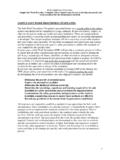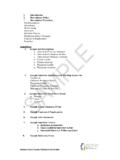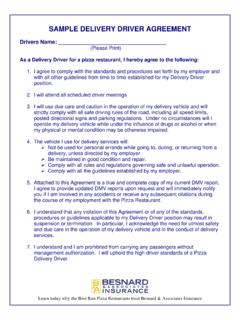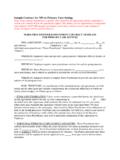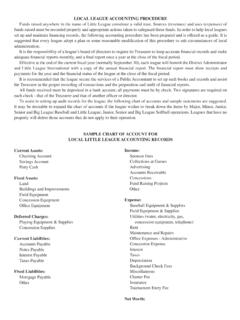Transcription of EMPLOYER SAMPLE PROCEDURES FOR HEAT …
1 EMPLOYER SAMPLE PROCEDURES FOR. heat illness prevention . August 2011. California employers with any outdoor places of employment must comply with the heat illness prevention Standard T8 CCR 3395. These PROCEDURES have been created to assist employers in crafting their own heat illness prevention PROCEDURES , and to reduce the risk of work related heat illnesses among their employees. These PROCEDURES are not intended to supersede or replace the application of any other Title 8. regulation, particularly T8 3203 Injury and illness prevention Program (IIPP). Title 8 CCR 3203. requires an EMPLOYER to establish, implement, and maintain an effective IIPP. The measures listed here may be integrated into the EMPLOYER 's Injury and illness prevention Program. The EMPLOYER must also be aware that other standards apply to heat illness prevention such as the requirement to provide for drinking water, first aid and emergency response.
2 Please note: These PROCEDURES provide the minimal steps applicable to most outdoor work settings and are essential to reducing the incidence of heat related illnesses. In working environments with a higher risk for heat illness ( , during a heat wave, or other severe working or environmental conditions), it is the EMPLOYER 's duty to exercise greater caution and additional protective measures beyond what is listed in this document, as needed to protect their employees. To effectively establish your company PROCEDURES , carefully review the key elements listed on this document, as well as the examples provided, then select and fill out the PROCEDURES applicable to your workplace. Please use additional paper when necessary. Implement and train employees and supervisors on your company PROCEDURES and follow-up to ensure your PROCEDURES are fulfilled.
3 Furthermore, to successfully tailor these PROCEDURES to your work activities, evaluate and consider the individual conditions present at your site (such as, but not limited to): (1) Size of the crew (2) The length of the work-shift (3) The ambient temperature (which can be taken either with the aid of a simple thermometer or by monitoring the weather). (4) The presence of personal protective equipment or additional sources of heat Again, these SAMPLE PROCEDURES do not include every workplace scenario, so it is crucial that your company evaluate and take into account conditions found in your individual workplace that are likely to cause a heat illness . Your written PROCEDURES should also: 1. Identify the designated person(s) that has been assigned the applicable task(s) ( supervisor, foreman, safety coordinator, crew leader).
4 2. Provide specific details required to carry out the task and ensure that the task is accomplished successfully ( how many water containers/shade structures, of what size, 1. distance to placement, frequency of water-level replenishment/weather-tracking/water breaks/reminders, etc). [For additional information, see the Enforcement Q&A. 3. Specify how these PROCEDURES will be communicated to your employees and in particular to the persons assigned these responsibilities ( via training, meeting), and how it will be ascertained that these company instructions and PROCEDURES are followed. ( EMPLOYER 'S NAME). The following designated person or persons (Program Administrator Safety Coordinator/Supervisor/Foreman/Field Supervisor/Crew Leader) have the authority and responsibility for implementing the provisions of this program at this worksite.]
5 Name/Title/Phone Number 1. _____. PROCEDURES for Provision of Water (include but are not limited to the following): Drinking water containers (of five to 10 gallons each) will be brought to the site, so that at least two quarts per employee are available at the start of the shift. All workers whether working individually or in smaller crews, will have access to drinking water. Paper cone rims or bags of disposable cups and the necessary cup dispensers will be made available to workers and will be kept clean until used. As part of the Effective Replenishment PROCEDURES , the water level of all containers will be checked periodically ( every hour, every 30 min), and more frequently when the temperature rises. Water containers will be refilled with cool water, when the water level within a container drops below 50.
6 Percent. Additional water containers ( five gallon bottles) will be carried, to replace water as needed. Ice will be carried in separate containers, so that when necessary, it will be added to the drinking water to keep it cool. Water containers will be placed as close as possible to the workers (given the working conditions and layout of the worksite), to encourage the frequent drinking of water. If field terrain prevents the water from being placed as close as possible to the workers, bottled water or personal water containers will be made available, so that workers can have drinking water readily accessible. 2. Water containers will be relocated to follow along with the crew, so drinking water will remain readily accessible. Water containers will be kept in sanitary condition. Daily, workers will be reminded of the location of the water coolers and of the importance of drinking water frequently.
7 When the temperature exceeds or is expected to exceed 90 degrees Fahrenheit, brief tailgate' meetings will be held each morning to review with employees the importance of drinking water, the number and schedule of water and rest breaks and the signs and symptoms of heat illness . Audible devices (such as whistles or air horns) will be used to remind employees to drink water. When the temperature equals or exceeds 95 degrees Fahrenheit or during a heat wave, the number of water breaks will be increased, and workers will be reminded throughout the work shift to drink water. During employee training and tailgate meetings, the importance of frequent drinking of water will be stressed. PROCEDURES for Access to Shade (include but are not limited to the following): Note: Follow the general guidance provided above, under the Provisions for Water (identify the person assigned the task and list the specific tasks that have to be carried out).
8 Shade structures will be opened and placed as close as practical to the workers, when the temperature equals or exceeds 85 degrees Fahrenheit. When the temperature is below 85 degrees Fahrenheit, access to shade will be provided promptly, when requested by an employee. Note: The interior of a vehicle may not be used to provide shade unless the vehicle is air-conditioned and the air conditioner is on. Enough shade structures will be available at the site, to accommodate at least 25 percent of the employees on the shift at any one time. Daily, workers will be informed of the location of the shade structures and will be encouraged to take a five minute cool-down rest in the shade. Shade structures will be relocated to follow along with the crew and they will be placed as close as practical to the employees, so that access to shade is provided at all times.
9 In situations where trees or other vegetation are used to provide shade (such as in orchards), the thickness and shape of the shaded area will be evaluated, before assuming that sufficient shadow is being cast to protect employees. In situations where it is not safe or feasible to provide access to shade ( , during high winds), a note will be made of these unsafe or unfeasible conditions, and of the steps that will be taken to provide shade upon request. For non-agricultural employers , in situations where it is not safe or feasible to provide shade, a note will be made of these unsafe or unfeasible conditions, and of the steps that will be taken to provide alternative cooling measures but with equivalent protection as shade. 3. PROCEDURES for Monitoring the Weather (include but are not limited to): The supervisor will be trained and instructed to check in advance the extended weather forecast.
10 Weather forecasts can be checked with the aid of the internet ( ), or by calling the National Weather Service phone numbers (see CA numbers below) or by checking the Weather Channel TV Network. The work schedule will be planned in advance, taking into consideration whether high temperatures or a heat wave is expected. This type of advance planning should take place all summer long. CALIFORNIA Dial-A-Forecast Eureka 707-443-7062. Hanford 559-584-8047. Los Angeles 805-988-6610 (#1). Sacramento 916-979-3051. San Diego 619-297-2107 (#1). San Francisco 831-656-1725 (#1). Prior to each workday, the forecasted temperature and humidity for the worksite will be reviewed and will be compared against the National Weather Service heat Index to evaluate the risk level for heat illness . Determination will be made of whether or not workers will be exposed at a temperature and humidity characterized as either extreme caution or extreme danger for heat illnesses.

